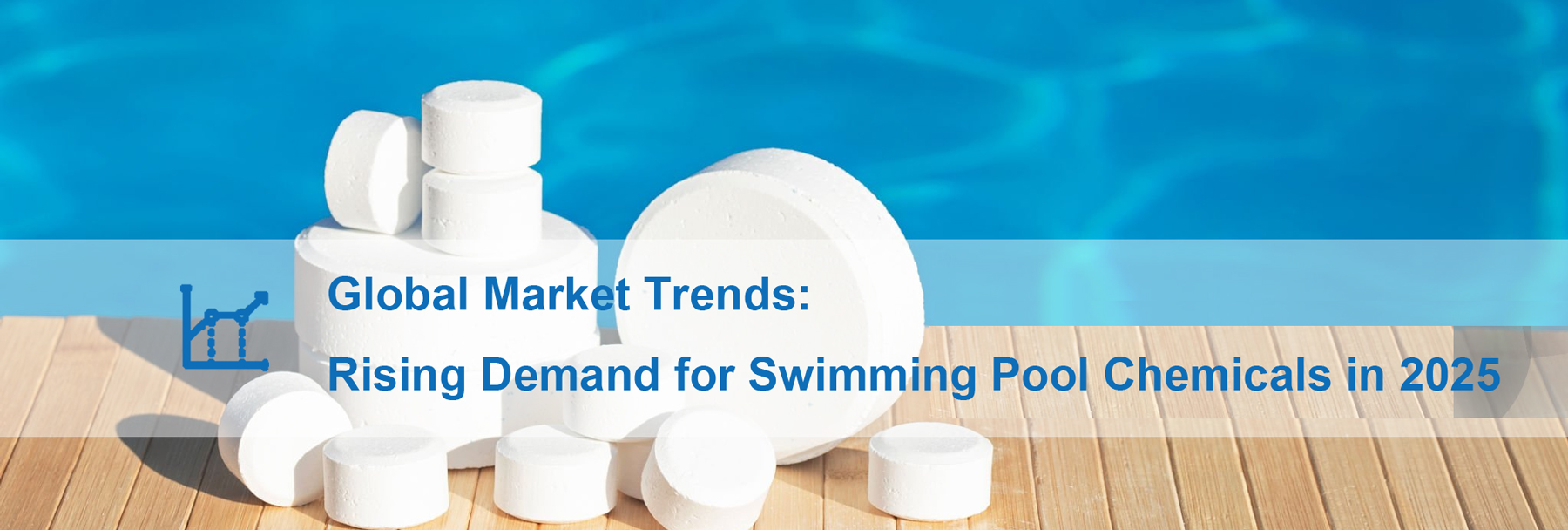The global pool industry is experiencing strong growth as demand for water recreation, wellness facilities, and private pools continues to rise. This expansion is driving a significant increase in demand for pool chemicals, particularly disinfectants such as sodium dichloroisocyanurate (SDIC), trichloroisocyanuric acid (TCCA), and calcium hypochlorite. 2025 is a critical year for distributors, importers, and wholesalers to capitalize on opportunities in this sector.
According to a recent industry report, the global pool chemical market is expected to maintain healthy growth through 2025. Key drivers of growth include:
Growing urbanization and tourism are driving more hotels, resorts, and wellness centers to install pools.
Public health awareness, especially in the post-pandemic era, has made safe and hygienic water treatment a priority.
Government regulations cover water safety, disinfection standards, and environmental sustainability.
For B2B buyers, these trends mean increased chemical procurement and greater regional product diversity.
Growing Demand for Key Pool Chemicals
Sodium Dichloroisocyanurate (SDIC)
SDIC remains one of the most popular chlorine-based disinfectants due to its stability, ease of use, and effectiveness. It is widely used in:
Residential and commercial swimming pools
Drinking water disinfection in specific markets
Public health projects
Demand for SDIC is expected to grow by 2025 in Latin America, the Middle East, and parts of Africa, where water treatment projects and public pool facilities are expanding.
Trichloroisocyanuric Acid (TCCA)
TCCA, available in tablet, granular, and powder forms, is favored by large swimming pools, hotels, and municipal facilities for its slow-release and long-lasting chlorine effect. In regions such as Europe and North America, TCCA remains a top choice for pool operators seeking cost-effective maintenance solutions.
Calcium Hypochlorite (Cal Hypo)
Calcium hypochlorite is a traditional disinfectant with strong oxidizing properties. It is particularly important in regions requiring fast-dissolving chlorine products. Demand is growing in South Asia and Africa, where distribution logistics make a stable solid chlorine product essential.
Regional Market Insights
North America
The United States and Canada remain the largest markets for pool chemicals, driven by the popularity of private residential pools and a mature leisure industry. Regulatory compliance, such as adherence to NSF and EPA standards, is crucial for suppliers in the region.
Europe
European countries are emphasizing environmentally friendly pool management. Demand for multi-purpose chlorine tablets, algaecides, and pH adjusters is growing. The EU Biocidal Products Regulation (BPR) continues to influence purchasing decisions, requiring suppliers to ensure product registration and compliance.
Latin America
Demand for pool disinfectants is surging in markets such as Brazil and Mexico. Rising middle-class incomes, government investment in tourism, and the growing popularity of private pools make the region a promising market for SDIC and TCCA distributors.
Middle East & Africa
The Middle East’s thriving hospitality industry is a strong growth area for pool chemicals. Countries such as the UAE, Saudi Arabia, and South Africa are investing heavily in resorts and water parks, creating new opportunities for chemical suppliers.
Asia Pacific
Residential and commercial pool construction is rapidly growing in China, India, and Southeast Asia. Demand for affordable and reliable pool chemicals, such as SDIC and Cal Hypo, is strong. Local regulations are also evolving, creating opportunities for international suppliers with quality certifications.
Regulations and Safety Considerations
Governments around the world are tightening their controls on water treatment chemicals. Importers and distributors must be mindful of the following:
BPR in Europe
REACH compliance for chemical imports
NSF and EPA certification in the United States
Local health ministry approvals in Latin America, Asia, and Africa
B2B buyers must partner with suppliers who can provide technical documentation, quality certifications, and a stable supply chain.
Supply Chain Dynamics
In recent years, the pool chemical industry has faced challenges due to fluctuations in raw material prices and logistics costs. However, by 2025:
Producers with in-house manufacturing capabilities and strong inventory management are expected to gain market share.
Buyers are increasingly seeking suppliers that can offer customized packaging, private labeling, and regional warehousing services.
Digitalization of procurement, including e-commerce and B2B platforms, is reshaping the marketing and sales of pool chemicals globally.
Sustainability and Green Trends
The market is increasingly focused on environmental sustainability. Distributors report that end users are increasingly demanding:
Eco-friendly algaecides and flocculants
Chlorine stabilizers that minimize waste
Energy-efficient dosing systems
This trend is particularly strong in Europe and North America, where green certifications are becoming a competitive advantage.
Opportunities for B2B Buyers
For distributors, importers, and wholesalers, the growing demand for pool chemicals in 2025 presents multiple opportunities:
Expand your product portfolio to include traditional chlorine products (SDIC, TCCA, Cal Hypo) and supplemental products (pH adjusters, algaecides, clarifiers). Furthermore, tailor traditional chlorine products to meet user needs, offering a variety of specifications, sizes, and packaging to ensure they meet customer requirements.
Target emerging markets such as Latin America, Asia Pacific, and Africa, where pool construction and water treatment projects are booming.
Leverage certifications and compliance to differentiate yourself in regulated markets such as Europe and North America.
Invest in supply chain resilience to ensure stable and timely delivery to customers.
2025 will be a dynamic year for the pool chemical market. With the growing global demand for a safe, hygienic, and enjoyable pool experience, chemicals such as sodium dichloroisocyanurate, trichloroisocyanuric acid, and calcium hypochlorite will remain at the core of pool maintenance. For B2B buyers, this means not only meeting growing consumer demands but also opportunities to expand into high-growth markets.
With the right supplier partnerships, a strong compliance strategy, and a focus on sustainability, distributors and importers can ensure long-term growth in this evolving industry.
Post time: Aug-20-2025


